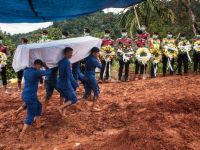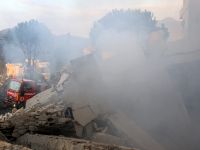Ethnic disturbances have also been reported from East Kalimantan where Unocal and TotalFinaElf supply much of the gas feed stock to the massive eight trains of the Bontang LNG plant, where an additional train is planned to come onstream in 2005.
TotalFinaElf has recently brought the 6tcf Peciko field into production at rates of over 750mmcfd, and further stages of development are planned, as they are at the 9tcf Tunu field in the delta area to the north.
Unocal is working on developing the deepwater Merah Besar and West Seno areas northeast of the delta area. Changes in licensees in the relevant PSCs, which have slowed up the pace of the project, seem to have been overcome.
It is now full speed ahead with the first TLP scheduled to go down in West Seno in two years' time in association with a production barge and two 58km pipelines to shore.
Whether a second TLP will join the first in developing Merah Besar two years later is now more of a matter for discussion than was previously believed.
One thing is certain: Unocal has been very successful in proving up deepwater reserves of the order of 6tcf, with an upside potential of 10tcf, and 500 million barrels of liquids for sustained production over a 20-year period.
A whole series of subsea tiebacks to the main platform, or platforms, is expected, taking production out into progressively deeper and deeper waters, down to at least 1500m and probably deeper when more wide ranging exploration has taken place.
South China Sea:
The southwestern margins of the South China Sea are bordered by Sarawak, Brunei and Sabah on the northwest coast of Kalimantan, and by the Philippines to the east and Vietnamese territorial waters to the west.
This is a very diverse part of the region, both culturally and geographically, but the course of history of their respective hydrocarbon extraction industries is following a strangely similar pattern.
None of them have really major oil field finds, although the Bach Ho field in Vietnam has seemed to improve considerably with age, but what they do have in increasing abundance is gas.
How to collect it, how to supply it to a relatively small domestic market at present and most importantly how to harness its potential to add considerably to the economic growth of the host country are all questions that each of them will need to face in the next few years.
The apparent exception to this very broad generalisation is Brunei, but this is because it is further into the development cycle than the others.
Negara Brunei Darussalam may not be the biggest and most powerful polity in the region, but because of its geography, its small size and population, it is certainly the richest per capita.
The priorities of its policy makers are, therefore, to try and sustain this mature situation for as long as possible, by responsible production policies and the careful depletion of each reservoir horizon to prevent formation damage and consequent loss of production.
To this end rationalisation work is being carried out on the Ampa-Fairley fields along with secondary and tertiary recovery schemes there and on the Champion field.
A sixth LNG train could add up to 4 million tonnes a year to the 6-7 million currently being produced at Lumut.
Brunei and neighbouring Sarawak and Sabah are Royal Dutch/Shell territory with a capital S.
Shell is very much on home ground here and not much happens without the company's participation. It has built up a very strong position in the gas supply arena, particularly in the LNG market.
Besides the proposed expansion of the Lumut plant in Brunei this coast also hosts the site of the Bintulu plants in Sarawak.
Currently two plants are operational and work on the third MLNG Tiga is far advanced. When it comes into production in 2003 the combined production capacity of the three Bintulu plants will be in the region of 23 million tonnes a year, and they will need to be supplied by production of over 3000mmcfd at peak.
New supplies are being developed in the deeper waters off Central Luconia from the Shell operated-Jintan field, and from Nippon Mitsubishi's Helang field in the Baram Delta region to the northeast.
Bintulu is, of course, the site of a commercial GTL plant. GTL technology is likely to be introduced throughout the region as gas production becomes increasingly more important over the next five years.
Looking yet further to the future, exploration has started in the truly deep waters off this coast.
The Kamunsu East finds, in Sabah block G, are expected to be the first of a whole series to be made along this shoreline. On trend to the northeast lies the Malampaya gas field off Palawan Island in the Philippines.
Again Shell is in the driving seat. Under development for start-up next year, Malampaya is a deep/shallow water field involving a series of deepwater subsea completed gas/ condensate wells tied back to a concrete gravity production platform in only 43m (OE July).
After separation of the liquids, which will be offloaded offshore, the dry gas is to be exported over 500km north to Luzon Island south of Metro Manila.
The find earlier in the year of an oil rim of maybe 200 million barrels, of which an initial 30 million are deemed recoverable, has made the project even more attractive in the way that the finding of a thin rim of oil in the Troll, Ormen Lange and Snohvit gas fields in the Norwegian sector has made them.
Vietnam:
The Vietnamese oil and gas industry is now entering a very progressive phase with the signing of a gas sales agreement with the BP Amoco/Statoil/ONGC Videsh consortium, which is responsible for the development of the Lan Tay and Lan Do fields with a fixed production platform fed by a series of subsea wells and export via a 370km long pipeline to shore.
A very aggressive timetable has been set for this project if it is to get into production by the end of 2002.
The Vietnamese experience has certainly been one of highs and lows so far. Most of the highs seem to have come on the Bach Ho, White Tiger field, which seems only to have improved with age since it first came onstream in 1986.
In those early days very antiquated Soviet-designed platforms were used and production rates were low. Today the picture is entirely different.
The field is pumping some 130,000b/d and enough gas to fill a 16in x 80km pipe to shore. At the time of writing Vietsovpetro, the operator, is in the process of taking delivery of a fourth FSO for the field.
This has been built to an incredibly tight schedule for Modec in Hitachi Zosen's Ariake yard.
The lowest of the lows have come in the Dai Hung field's repeated inability to live up to its early promise for a whole succession of operators from BHP to Petronas.
Now Vietsovpetro itself is hoping to revitalise the field using two new subsea completed wells tied back to the still going strong Deepsea Pioneer (OE November 1994) which first came to prominence on Hamilton's Argyll field, the first UK North Sea oilfield to come into production (OE January 1975).
A relatively unexplored shelf compared to say the North Sea or Gulf of Mexico, Vietnam will probably be host to several pleasant surprises in the coming years - indeed, only last month a major new find was reported by the Conoco-led Cuu Long Joint Operating Company in block 15-1, northwest and closer inshore than the Bach Ho field, for which reserve figure estimates have appeared in the East Asian Press of 400 million barrels of liquids and 1200 billion cubic feet of gas. Whether these are accurate or not waits to be seen.
Conclusion:
The oil age in South East Asia may be passing, but the gas age is well and truly on its way. Projections of demand for LNG have been made to reach 160-175 million tonnes or more each year by the end of this decade, practically doubling the present demand.
As much of this market is in North East Asia, or would be accessible across the Pacific from South East Asia, the region as a whole is extremely well placed to meet this challenge.
Further, sales to the emerging markets in China and India, where the potential for LNG use is enormous, are just in the very earliest stages of negotiation. South East Asia is expected to take a substantial slice of this new business and thus lay a firm foundation for continued economic growth into the foreseeable future.
Dr Roger Knight
© 2001 Mena Report (www.menareport.com)







